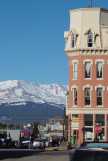Because of the poor spring snow conditions, on the 22nd we put the skis in their rack on the Jeep and drove over Frémont Pass from Leadville into Summit County, the heart (or other metaphorical internal organ) of Colorado's ski industry. After walking around the business district of Frisco, driving to see if my uncle's former cabin on Lake Dillon is still there (it's not, apparently), and walking around the business district of Breckenridge, Mary had an observation: "These ski towns are all the same."

RIGHT: View down 7th Street in Leadville, Colorado, which has not yet succombed to being a ski town.
In what way, for instance, does Main Street in Breckenridge differ from Elk Avenue in Crested Butte? Answer: Main Street in Breckenridge is longer and slightly wider.
At the core, the old mining town, Historic Register plaques in place--bars, ski/snowboard rentals, antiques shops, real-estate offices, interior decorators (for the million-dollar-plus trophy homes), boutiques for "adventure apparel," real-estate offices, restaurants, souvenir stores, maybe a lone museum ("Our Mining Heritage"), real-estate offices.
The next ring out: newer commercial buildings--the professional offices, the municipal offices, the fire station, the police department.
Then the condominiums with names like Edelweiss.
Then the upscale subdivisions for the "trophy homes", so often named with the "The (blank) at (blank)" formula that is supposed to exude classiness to buyers in Denver or Dallas. Example: "The Turds at Elk Meadows."
The other formula applies to ski towns built from scratch, such as Vail, in which case there is no core, only Bogus Bavarian or whatever style was in favor at the time of construction, with an outer ring of tasteful strip malls.
One visit to Summit County per decade is enough.
On the plus side: Weber's Books, 100 S. Main in Breckenridge, tiny but well-stocked, had an autographed copy of Mary Sojourner's new collection of essays, Solace.



<< Home